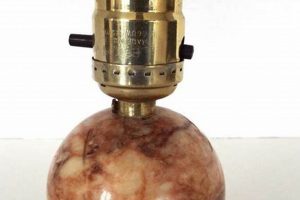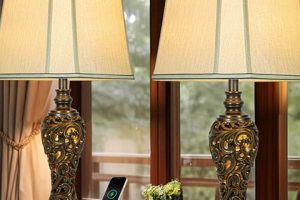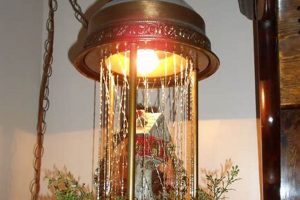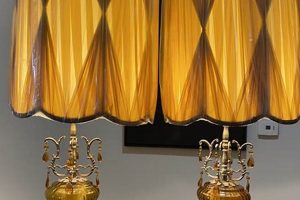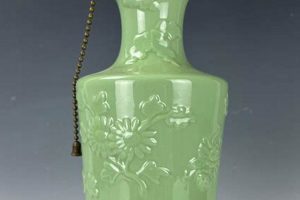A decorative lighting device, frequently crafted during the Victorian era and early 20th century, features a small lamp or candle enclosed within a glass shade. These pieces, valued for their aesthetic appeal and delicate construction, provided a soft, diffused light. Examples include Clarke’s Pyramid lamps, often marked with the manufacturer’s stamp and showcasing ornate designs.
These objects represent a confluence of utility and artistic expression. Their historical significance lies in reflecting the social and technological conditions of their time, providing illumination before widespread electrification while serving as coveted household ornaments. Their value to collectors stems from their relative scarcity, craftsmanship, and the inherent beauty of antique glass and metalwork.
The following sections will delve into the diverse styles, manufacturing techniques, and identification markers that define these charming relics, offering a guide for both novice enthusiasts and seasoned collectors.
Tips on Collecting and Preserving Antique Lighting Devices
The acquisition and maintenance of antique lighting devices require careful consideration to ensure their authenticity and longevity. The following tips offer guidance on evaluating and safeguarding these historical artifacts.
Tip 1: Authenticate Markings. Examine pieces closely for manufacturer’s marks, such as those found on Clarke’s examples. These markings provide crucial evidence of origin and can aid in determining authenticity. Consult reference guides to verify the legitimacy of these marks.
Tip 2: Assess Glass Quality. Antique glass often exhibits imperfections such as bubbles or striations, which are indicative of hand-blown processes. However, be wary of excessive damage, such as chips or cracks, which can diminish value and structural integrity.
Tip 3: Evaluate Metal Components. Inspect metal elements for signs of wear and corrosion. Original brass or spelter bases should be free from significant damage and retain their original patina. Avoid pieces where excessive polishing or replacement parts are evident.
Tip 4: Research Historical Context. Understand the historical period and manufacturing techniques associated with specific styles. Knowledge of popular designs and prevalent materials can help distinguish genuine pieces from reproductions.
Tip 5: Handle with Care. Due to the delicate nature of glass and metal, handle these objects with utmost care. Employ lint-free cloths and avoid abrasive cleaners when dusting. Store in a stable environment away from direct sunlight and extreme temperature fluctuations.
Tip 6: Consider Provenance. When possible, inquire about the history of the piece. Documented provenance can increase value and provide insight into its authenticity. Dealers and auction houses should be able to provide details regarding prior ownership and known history.
These guidelines serve as a foundation for informed collecting and responsible preservation. Through careful evaluation and proper maintenance, these historical objects can continue to be appreciated for generations to come.
The subsequent sections will delve into specific restoration techniques and resources available for further research, ensuring the continued enjoyment of these treasured antiques.
1. Glass Composition
The glass composition of vintage lighting devices significantly impacts their aesthetic qualities and historical value. Different formulations result in variations in color, transparency, and durability. For example, lead crystal, popular in higher-end pieces, offers superior refractive properties, creating a more brilliant and sparkling light diffusion. Conversely, less expensive soda-lime glass was often used in mass-produced items, resulting in a less luminous effect and greater susceptibility to thermal shock. The presence of specific colorants, such as manganese to achieve amethyst hues or uranium for vaseline glass, further influences the light emitted and the desirability of the piece. Therefore, glass composition is a key determinant of the visual appeal and material integrity of each example.
Understanding glass composition allows for more accurate dating and authentication. The development of specific glassmaking techniques and the introduction of new chemical formulations occurred at different periods. For instance, pressed glass, which enabled intricate designs to be produced quickly and inexpensively, became prevalent in the mid-19th century. Identifying such manufacturing processes helps differentiate authentic vintage pieces from later reproductions. Furthermore, certain types of glass are more prone to degradation over time, such as devitrification or clouding, which can indicate the age and storage conditions of the device.
In summary, the composition of the glass is not merely a material characteristic but a fundamental aspect that defines its historical context, aesthetic value, and physical integrity. Recognizing the nuances of different glass types enables informed collecting and preservation efforts. However, accurately identifying the precise glass formulation often requires specialized knowledge and equipment, underscoring the importance of consulting with experts when assessing particularly valuable or unique lighting devices.
2. Manufacturer Identification
The identification of the manufacturer is a critical component in evaluating any antique lighting device. Markings, often subtle and requiring careful examination, offer direct evidence of origin, influencing value and authenticity assessment. The presence of a recognized maker’s mark, such as that of Clarke’s on their “Pyramid” lamps, provides immediate validation and context. Conversely, the absence of such a mark necessitates more detailed analysis of design, construction, and materials to infer potential origin, a process less definitive and more prone to error.
The impact of manufacturer identification extends beyond simple authentication. Certain manufacturers achieved renown for specific designs or innovations. For instance, a lighting device attributed to a known glassworks celebrated for its colored glass production carries greater significance than an otherwise identical item with an unknown provenance. This understanding informs pricing within the antique market and guides collectors in discerning rarity and artistic merit. Identifying the manufacturer also opens avenues for tracing the device’s historical trajectory, potentially revealing information about its original retail context and previous ownership.
Therefore, the ability to identify the manufacturer is paramount in assessing these items. While marks offer direct confirmation, their absence demands meticulous examination of construction techniques, materials, and design elements. Such skills empower collectors, researchers, and dealers to navigate the complexities of the antique market, ensuring informed acquisitions and contributing to the preservation of these artifacts. However, it must be acknowledged that definitive identification can be challenging, often requiring specialized knowledge and reference materials.
3. Historical Context
The emergence and proliferation of these lighting devices were intrinsically linked to the Victorian era and the early 20th century. The societal desire for improved domestic illumination, coupled with advancements in glass manufacturing and candle production, created a fertile ground for their development. The historical context provides insight into the design aesthetics, materials utilized, and the intended function of these objects within the homes of the period. For instance, the shift from open-flame oil lamps to enclosed candle lamps reflected a growing concern for safety and a desire for cleaner, more controllable light sources. The stylistic preferences of the time, heavily influenced by Victorian romanticism and later by Art Nouveau and Art Deco movements, are visibly reflected in the ornate designs and delicate craftsmanship of these lighting items. Analyzing the historical context reveals that these pieces were not simply functional objects but also decorative elements intended to enhance the ambiance of domestic spaces.
The importance of the historical context extends to understanding the socio-economic factors that influenced production and distribution. The rise of mass production techniques, for example, made these lamps more accessible to a wider range of households, though higher-quality, handcrafted examples remained symbols of affluence. The historical availability of specific materials, such as particular types of glass or metals, also shaped the design and construction of these lamps. Furthermore, understanding the marketing strategies employed by manufacturers, as evidenced by period advertisements and catalogs, provides insight into the intended audience and the perceived value of these items. These aspects collectively contribute to a more comprehensive understanding of these historical artifacts.
In summary, understanding the historical context is essential for accurately appraising, authenticating, and preserving these antique lighting devices. It provides a framework for interpreting the design, materials, and manufacturing techniques employed, enabling collectors and historians to distinguish between genuine period pieces and later reproductions or adaptations. By placing these objects within their original social, economic, and technological milieu, a richer appreciation for their significance as cultural artifacts is fostered. The challenges lie in piecing together fragmented historical evidence and avoiding anachronistic interpretations, requiring a rigorous and informed approach.
4. Base Material
The base material of antique lighting devices significantly influences their stability, aesthetic character, and long-term preservation. Common base materials include brass, spelter (a zinc alloy), and occasionally, cast iron. The choice of material directly affected the structural integrity of the device, ensuring the glass shade remained securely positioned. Brass, known for its durability and resistance to corrosion, provided a solid and visually appealing foundation for higher-end lamps. Spelter, being less expensive, was frequently used in mass-produced items, often finished with a brass-like coating. The base also served as a decorative element, with intricate castings and embossed designs reflecting the stylistic trends of the period. For example, a Clarke’s Pyramid lamp might feature a heavily ornamented brass base with claw feet, indicative of Victorian design sensibilities, whilst a later Art Deco example might exhibit a streamlined spelter base with geometric patterns.
The type of base material can also indicate the age and intended market for a particular lamp. Brass bases, being more costly, were typically found on lamps marketed towards wealthier households. The condition of the base material is a key factor in determining the overall value of a lamp. Corrosion, damage, or poorly executed repairs can significantly detract from its worth. Understanding the characteristics of different base materials enables collectors to authenticate and properly care for these items. For instance, brass requires specific cleaning agents to maintain its luster without damaging the patina, while spelter is more susceptible to corrosion and may require specialized conservation treatments.
In essence, the base material of antique lighting devices is not merely a functional component but an integral aspect of their design, historical context, and valuation. Distinguishing between various base materials, understanding their properties, and recognizing the manufacturing techniques employed are crucial skills for collectors, historians, and preservationists. The challenges lie in accurately identifying corroded or heavily patinated materials and in discerning original finishes from later alterations, necessitating careful examination and, in some cases, expert consultation.
5. Shade Style
The shade style of a lighting device profoundly influences its aesthetic presentation and light diffusion characteristics. For vintage examples, shade style is a key identifier of its historical period, intended function, and overall value.
- Shape and Silhouette
The contour of the shade, whether spherical, conical, or multi-faceted, dictates the direction and intensity of the light. Victorian examples often feature ornate, curvilinear shapes, while Art Deco shades exhibit geometric patterns. The shade silhouette significantly contributes to the lamp’s visual appeal, directly impacting its perceived elegance or simplicity.
- Glass Type and Color
Variations in glass type, such as clear, frosted, or colored glass, alter the quality and ambiance of the emitted light. Clear glass provides maximum brightness, while frosted glass diffuses the light to create a softer glow. Colored glass, often achieved through the addition of metallic oxides, adds warmth or vibrancy to the illumination. The selected glass type profoundly shapes the aesthetic effect.
- Decoration and Embellishment
Shades often feature decorative elements, including hand-painted designs, etched patterns, or applied ornamentation. These embellishments reflect the artistic sensibilities of the period and can serve as markers of specific manufacturers or design movements. Elaborate decorations enhance the lamp’s decorative appeal and can increase its value to collectors.
- Material Composition
While glass is the most common material, some examples incorporate other materials, such as metal filigree or fabric lining. These additions modify the light diffusion and add textural contrast. The choice of materials reflects the designer’s aesthetic preferences and influences the lamp’s overall weight and fragility.
In summation, the shade style is a defining characteristic of each device, reflecting its historical period, intended function, and the artistic preferences of its creator. Analyzing shade style enables a deeper understanding of the lighting device’s cultural significance and enhances its appreciation as a decorative art object.
6. Operational Condition
The operational condition of a lighting device is a primary determinant of its value and utility. Assessing the functionality of these delicate antiques requires careful consideration of several interconnected factors. The ability of a lamp to safely and reliably provide illumination directly impacts its desirability among collectors and end-users alike.
- Electrical Integrity
For electrified examples, the integrity of the wiring, sockets, and switches is paramount. Deteriorated wiring poses a significant fire hazard and necessitates professional restoration. Original sockets and switches, while historically significant, may not meet modern safety standards, requiring replacement or adaptation. Functional electrical components are crucial for safe operation.
- Candle Holder Functionality
For candle-operated lamps, the presence and condition of the candle holder are critical. Damaged or missing candle holders render the lamp unusable in its original intended form. The stability and heat resistance of the holder directly influence the safety of operation. A functional candle holder preserves the lamp’s original design and utility.
- Glass Shade Condition
The glass shade must be free from significant cracks or chips that compromise its structural integrity and aesthetic appeal. Minor imperfections may be acceptable, reflecting the age of the piece, but substantial damage diminishes its value and safety. The shade’s ability to effectively diffuse light is directly related to its condition.
- Overall Stability
The lamp’s base must provide adequate stability to prevent accidental tipping. A wobbly or unstable base poses a safety hazard and suggests potential structural damage. The stability of the base is particularly important for candle-operated lamps, where an accidental fall could ignite surrounding materials.
The operational condition, encompassing electrical safety, candle holder functionality, glass shade integrity, and overall stability, is not merely a matter of practical utility but a critical aspect of the lamp’s historical value and aesthetic presentation. These factors collectively determine the lamp’s suitability for display, use, or preservation, influencing its market value and long-term viability as a collectible antique.
Frequently Asked Questions About Vintage Fairy Lamps
This section addresses common inquiries regarding these antique lighting devices, providing concise and factual responses.
Question 1: How does one distinguish an authentic antique piece from a modern reproduction?
Genuine examples often exhibit subtle imperfections indicative of hand-blown glass and manufacturing techniques predating modern automation. Examination of manufacturer’s marks, construction details, and glass composition is essential. Consulting with an expert is advisable for uncertain cases.
Question 2: What is the typical lifespan of a vintage fairy lamp?
Lifespan varies greatly depending on materials, usage patterns, and environmental conditions. With proper care and preservation, these pieces can endure for well over a century. Deterioration due to exposure to moisture, extreme temperatures, or mishandling is the primary factor limiting lifespan.
Question 3: What is the best method for cleaning these delicate items?
Gentle cleaning with a soft, lint-free cloth and mild, pH-neutral soap is recommended. Abrasive cleaners and harsh chemicals should be avoided, as they can damage the glass or metal components. Disassembly for cleaning should only be performed by experienced individuals.
Question 4: How does one assess the value of such an artifact?
Value is determined by several factors, including rarity, condition, manufacturer, historical significance, and aesthetic appeal. Researching comparable sales, consulting with appraisers, and examining auction records are essential steps in valuation.
Question 5: Can vintage fairy lamps be safely used with candles today?
While using candles may be historically accurate, modern safety precautions are paramount. Short, stable candles should be used, and the lamp should never be left unattended while lit. Consideration should be given to heat buildup and potential fire hazards.
Question 6: What are the ideal storage conditions for a vintage example?
Storage in a stable environment, away from direct sunlight, extreme temperatures, and humidity, is recommended. Wrapping delicate components in acid-free tissue paper and storing the lamp in a padded container can further protect it from damage.
Accurate assessment, careful handling, and appropriate storage are critical for preserving the value and integrity of these historical items.
The following section will explore specific restoration techniques for vintage lighting devices, offering insights into preserving their functionality and aesthetic appeal.
Conclusion
The preceding discussion has elucidated the various facets of the “vintage fairy lamp,” encompassing its historical context, manufacturing processes, valuation factors, and preservation techniques. This exploration underscores the multifaceted nature of these objects, positioning them as artifacts of historical significance and aesthetic value.
Continued research, responsible collecting practices, and meticulous preservation efforts remain essential for ensuring the enduring legacy of the “vintage fairy lamp.” Further investigation into design variations and manufacturers will enhance the collective understanding of these relics, and their significance within the broader context of decorative arts will further cement their place in history.


